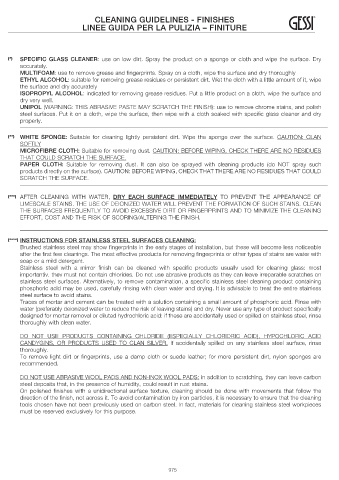Page 975 - GESSI - CATALOGO 2022
P. 975
CLEANING GUIDELINES - FINISHES
LINEE GUIDA PER LA PULIZIA – FINITURE
(*) SPECIFIC GLASS CLEANER: use on low dirt. Spray the product on a sponge or cloth and wipe the surface. Dry
accurately.
MULTIFOAM: use to remove grease and fingerprints. Spray on a cloth, wipe the surface and dry thoroughly
ETHYL ALCOHOL: suitable for removing grease residues or persistent dirt. Wet the cloth with a little amount of it, wipe
the surface and dry accurately
ISOPROPYL ALCOHOL: indicated for removing grease residues. Put a little product on a cloth, wipe the surface and
dry very well.
UNIPOL (WARNING: THIS ABRASIVE PASTE MAY SCRATCH THE FINISH): use to remove chrome stains, and polish
steel surfaces. Put it on a cloth, wipe the surface, then wipe with a cloth soaked with specific glass cleaner and dry
properly.
(**) WHITE SPONGE: Suitable for cleaning lightly persistent dirt. Wipe the sponge over the surface. CAUTION: CLAN
SOFTLY
MICROFIBRE CLOTH: Suitable for removing dust. CAUTION: BEFORE WIPING, CHECK THERE ARE NO RESIDUES
THAT COULD SCRATCH THE SURFACE.
PAPER CLOTH: Suitable for removing dust. It can also be sprayed with cleaning products (do NOT spray such
products directly on the surface). CAUTION: BEFORE WIPING, CHECK THAT THERE ARE NO RESIDUES THAT COULD
SCRATCH THE SURFACE.
(***) AFTER CLEANING WITH WATER, DRY EACH SURFACE IMMEDIATELY TO PREVENT THE APPEARANCE OF
LIMESCALE STAINS. THE USE OF DEIONIZED WATER WILL PREVENT THE FORMATION OF SUCH STAINS. CLEAN
THE SURFACES FREQUENTLY TO AVOID EXCESSIVE DIRT OR FINGERPRINTS AND TO MINIMIZE THE CLEANING
EFFORT, COST AND THE RISK OF SCORING/ALTERING THE FINISH.
(****) INSTRUCTIONS FOR STAINLESS STEEL SURFACES CLEANING:
Brushed stainless steel may show fingerprints in the early stages of installation, but these will become less noticeable
after the first few cleanings. The most effective products for removing fingerprints or other types of stains are water with
soap or a mild detergent.
Stainless steel with a mirror finish can be cleaned with specific products usuallv used for cleaning glass: most
importantiv. thev must not contain chlorides. Do not use abrasive products as they can leave irreparable scratches on
stainless steel surfaces. Alternatively, to remove contamination, a specific stainless steel cleaning product containing
phosphoric acid may be used, carefully rinsing with clean water and drying. It is advisable to treat the entire stainless
steel surface to avoid stains.
Traces of mortar and cement can be treated with a solution containing a small amount of phosphoric acid. Rinse with
water (preferably deionized water to reduce the risk of leaving stains) and dry. Never use any type of product specifically
designed for mortar removal or diluted hydrochloric acid: if these are accidentally used or spilled on stainless steel, rinse
thoroughly with clean water.
DO NOT USE PRODUCTS CONTAINING CHLORIDE (ESPECIALLY CHLORIDRIC ACID), HYPOCHLORIC ACID
CANDYGINS, OR PRODUCTS USED TO CLAN SILVER. If accidentally spilled on any stainless steel surface, rinse
thoroughly.
To remove light dirt or fingerprints, use a damp cloth or suede leather; for more persistent dirt, nylon sponges are
recommended.
DO NOT USE ABRASIVE WOOL PADS AND NON-INOX WOOL PADS: in addition to scratching, they can leave carbon
steel deposits that, in the presence of humidity, could result in rust stains.
On polished finishes with a unidirectional surface texture, cleaning should be done with movements that follow the
direction of the finish, not across it. To avoid contamination by iron particles, it is necessary to ensure that the cleaning
tools chosen have not been previously used on carbon steel. In fact, materials for cleaning stainless steel workpieces
must be reserved exclusively for this purpose.
975

